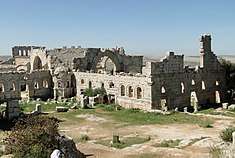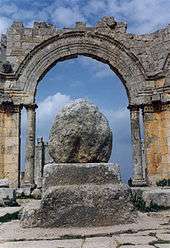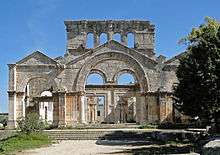Church of Saint Simeon Stylites
The Church of Saint Simeon Stylites (Arabic: كنيسة مار سمعان العمودي, romanized: Kanīsat Mār Simʿān el-ʿAmūdī) is a building that can be traced back to the 5th century, located approximately 30 kilometres (19 mi) northwestern part of Aleppo, Syria. It is one of the oldest surviving church complexes. It was constructed on the site of the pillar of Saint Simeon Stylites, a renowned recluse monk. The church is popularly known as either Qalaat Semaan (قلعة سمعان, Qalʿat Simʿān, the 'Fortress of Simeon') or Deir Semaan (دير سمعان, Dayr Simʿān, the 'Monastery of Simeon').
| Church of Saint Simeon Stylites | |
|---|---|
كنيسة مار سمعان العمودي قلعة سمعان | |
 Overview of the complex | |
| Religion | |
| Affiliation | Christian |
| Year consecrated | 475 AD |
| Status | in ruins |
| Location | |
| Location | Mount Simeon, Aleppo Governorate, Syria |
| Geographic coordinates | 36°20′03″N 36°50′38″E |
| Architecture | |
| Type | Church |
| Style | Byzantine architecture |

History
Saint Simeon was born in 386 AD in the Amanus mountains village. He entered a monastery at the age of 16, but he was soon judged to be unsuited for cenobitic life due to his extravagant asceticism. Following the example of Saint Anthony, he attempted to live the life of a hermit ascetic in the wilderness, but his feats of physical endurance and self denial attracted pilgrims seeking religious instruction and other devout admirers. In an effort to escape from such distractions, he resolved to live on a small platform atop a 3-meter column. The height of the column was raised over time to 18 meters. From his perch, Simeon preached twice a day to the crowds who gathered to witness this spectacle or self-mortifcation. A ladder attached to he column allowed messengers to bring food and written messages to Simeon, who also sent letters to his followers this way. Such was his renown and reputation for sanctity that the eastern emperors Theodosius, Leo, and Theodosius III sought his advice a implored his intervention in state affairs. Simeon lived on the column for years, dying in AD 459 at the approximate age of 70. After a fierce contest for the possession of his remains between Antioch and Constantinople was settled in favor of Antioch, the solemn translation of his remains to Antioch was accompanied by a procession of the patriarch of Constantinople, 6 bishops, the Master-General of the East, 21 counts and tribunes and 6,000 soldiers.[2] His tomb became a major pilgrimage destination.[3]
A few decades following Saint Simeon's death, a large monastic church (occupying over 5,000 square meters) was constructed in on the site where his pillar stood. The church was made up of four basilicas that emanated from the sides of a central octagon. The octagonal crossing was surmounted by a dome; at its center stood Simeon’s column. The church was the centerpiece of a walled monastic complex that included two minor churches, and pilgrim hostels.
Long abandoned and ruined, the site is part of the series of ruins referred as the Dead Cities of Syria. Until just recently, remains of the pillar of Saint Simeon still stood, despite having been whittled down to a block only a few meters tall from years of pilgrims cutting down small parts for themselves as relics; substantial surviving parts of the column shaft were last visible in the 17th century.[4][5] The dome above it apparently survived until the 19th century.[5]
Architecture
As opposed to many cathedrals that were constructed in medieval Europe, the idea of the church of Saint Simeon was born and realized as one project over a short span of time. It was designed in a cruciform made up of four distinct basilica complexes. The grounds for construction of the church were born by the imperial authorities who later promoted the course. Primarily, the high number of pilgrims who frequently flocked to the column of Saint Simeon to pray necessitated the construction of the church in 473 AD.[3]
The ambitious plan of the church of Saint Simeon complex portrays numerous architectural designs. The fundamental concept of the three-aisled basilica can be traced to the lasting traditions of the Romans. It is reported that the main basilica and the baptistery were the first to be constructed. Subsequently, the monastery and the fixtures to the baptistery followed. Ultimately, the other parts of the complex including the colossal arch on the Via Sacra concluded the construction process. Apparently, the best relics that are evident from the church of Saint Simeon are the massive arch that is located at the beginning of the start of the Via Sacra on the way to the cathedral on the mountain.[6] Besides, two monasteries are visible from the church; a bazaar which is a few little housings, and a tomb chapel. The following are the numerous grouped buildings that were arranged at the complex.
The four-basilica church
The shaped like cross church was finely preserved, and it offers an excellent view in the spring with all the freshly blossomed flowers. When viewed from inside, the pillar of Saint Simeon is still apparent, only that it has been reduced to approximately 2 meters high boulder in the middle of the courtyard.[7] The reduction in the length of the pillar can be attributed to many years of relic-gathering by pilgrims. The courtyard is octagonal and is bordered by four basilicas in the shape of a rood-tree and described as a four-basilica church. Apparently, the idea of a crucifix was to represent the crucifixion of Jesus on the cross. Evidently, the east basilica is considerably bigger compared to other basilicas.[8] The more significant size can be attributed to the critical role it played in hosting all the key ceremonies, making it most important.
The U-shaped monastery
Bordering the south partition of the eastern basilica laid a chapel and a monastery. Originally, Deir Semaan (Simeon Monastery) bore the name of Telanissos and was established to make the most of the two productive plains that surrounded it. In the mid of the 5th century AD, the locals established a monastery on the plains and in 412 AD, Saint Simeon opted to be part of it.[3] Later on, he left the locals to live there as he went to live in the mountain above the plains where the monastery was situated.
Baptistery
The baptistery was located on the opposite side of the southern basilica, down the sacred road known as Via Sacra. The baptistery was constructed shortly after the construction of the main church, and it served as a crucial part of the pilgrimage complex.[9] The design of the baptistery was impeccable and was often regarded to be amongst the remarkable artifacts of the Christian architecture in the entire Syria. The baptistery was constructed in two phases; the baptistery itself and then some related little basilicas later. The baptistery took the form of an octagonal drum that lay on the top of the square base of the building. At some point, it was filled with a wooden roof, with shape either like a cone or dome.[10] The inner octagon was covered in a rectangular outer building. Evidently, at the far end of the chamber to the east lays a semi-circular apsidole that encompasses a tunnel with steps heading down to its location.
Extensions to the Baptistery
The processional route guides towards the Deir Semaan (Simeon Monastery) emanates from the western side of the baptistery. Besides, at the opening of this road is the monumental arch, which comes from the monastery to the direction of the baptistery.[10] The location of the church on the hill provides views of the surrounding countryside.
UNESCO
As of June 2011, the Church and surrounding village were designated by United Nations Educational, Scientific and Cultural Organization (UNESCO) as part of the "Ancient Villages of Northern Syria", a World Heritage site.[11] There is much value attached to the building because of its representation of great sacrifice for a holy course as manifested by Saint Simeon.
Wars
Saint Simeon Church has continuously faced destruction by wars.
Arab-Byzantine War
The church was negatively affected by the Arab conquest during the agitation for the control of Syria between the Byzantines and the Arabs. Notwithstanding this, the Byzantines fortified the church even after such destruction. The complex was attacked and conquered by the Emir of Aleppo Sa'd al-Dawla, and it was considered a fortress. This compromised the symbolism of the complex as a holy site. This did not stop worshippers from continuing to visit the complex for the purpose of worship of God.
Syrian Civil War
The war in Syria has caused much damage to the historical sites because of the fighting between the opposing sides in the conflict. Additionally, the building has been destroyed by illegal digging and stone removal. The ruined building forms part of the ancient buildings on the Northern side of Syria, which have been ruined. The structure has been under threat from both the Syrian and Turkish governments through their conflict on the link contested by the two governments through the Bab Al-Hawa border crossing. On 28 May 2015, the church was captured by the Kurdish YPG/YPJ but was subsequently lost to factions opposing the Assad government. In May 2016 the Russian Air Force attacked the church, damaging the remains of the pillar of St Simeon aa well as the rest of the ruins.[1][12] By 8 February 2020, the hilltop near the site was occupied by the Turkish Land Forces.[1]
Gallery
 The Baptistry
The Baptistry South facade of Church of Saint Simeon
South facade of Church of Saint Simeon Icon of Saint Simeon
Icon of Saint Simeon Facade of Church of Saint Simeon
Facade of Church of Saint Simeon Pattern in the walls of the Church
Pattern in the walls of the Church Remains of the atrium
Remains of the atrium
See also
- Oldest churches in the world
- History of Roman and Byzantine domes
References
- Darke, Diana (2020-02-08). "Forgotten amid the bombs: Idlib's ancient riches". BBC News. Retrieved 2020-02-21.
- Gibbon, Edward (1977). The History of the Decline and Fall of the Roman Empire. vol. II. New York: Modern Library. pp. 362–363. ISBN 9780394604022.
- Hase, Karl V.; Blumenthal, Charles E.; Wing, Conway P. (1855). A History of the Christian Church. New York: D. Appleton and Company.
- Lawler, Michael G; Salzman, Todd A.; Burke-Sullivan, Eileen (2014). The Church in the Modern World: Gaudium Et Spes Then and Now. Collegeville, MN: Liturgical Press.
- Greenhalgh, Michael (2016-11-03). Syria's Monuments: Their Survival and Destruction. BRILL. pp. 251–253, & 524. ISBN 978-90-04-33460-1.
- Untener, Ken. Treasures of the Church. Cincinnati, OH: St. Anthony Messenger Press, 1998. Sound recording.
- Bonsanti, Giorgio; Roli, Ghigo; Sartarelli, Stephen (1998). The Basilica of St. Francis of Assisi: glory and destruction. New York, N.Y: H.N. Abrams.
- Stevenson, Joseph (1853). The Church Historians of England. London: Seeleys.
- M'Gavin, William (1833). The Protestant: Essays on the Principal Points of Controversy between the Church of Rome and the Reformed. Rochester, NY: Parsons & Phelps.
- Williams, Issac (2011). The Baptistery: Or, The Way of Eternal Life. Ann Arbor, MI: Proquest LLC.
- "Ancient Villages of Northern Syria". UNESCO. Retrieved 14 July 2011.
- Spencer, Richard (2016-05-13). "Syrian monastery where St Simeon sat on a pillar for four decades damaged by missile attack". The Telegraph. ISSN 0307-1235. Retrieved 2020-02-21.
- Gary Vikan, Byzantine Pilgrimage Art (Dumbarton Oaks Papers, 1982), 8–9.
- Simeon Citadel and Dead Cities, Suggestion to have Saint Simeon Stylites recognized as a UNESCO world heritage site, in 2006, as part of "Simeon Citadel and Dead Cities" project.
- "St. Simeon Church." Syria Gate (accessed 2008).
- Sacred Destinations
- https://whc.unesco.org/en/list/1348/multiple=1&unique_number=1761
Further reading
- Weitzmann, Kurt, ed., Age of spirituality: late antique and early Christian art, third to seventh century, no. 590, 1979, Metropolitan Museum of Art, New York, ISBN 9780870991790
External links
![]()
- 180 photographs in gallery, PBase
- Gatier, P.; T. Sinclair; M. Ballance; R. Warner; R. Talbert; T. Elliott; S. Gillies. "Places: 658606 (Symeon, Mon.)". Pleiades. Retrieved March 8, 2012.